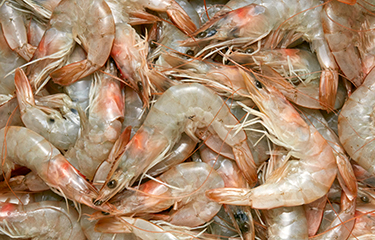Global shrimp production was significantly lower than projected in 2020 as it took an unexpected hit from the COVID-19 pandemic.
Before the pandemic, experts were predicting that the shrimp industry would see a slight increase in production in 2020, as is typical every year barring any emerging diseases. As Charoen Pokphand Foods Executive Vice President Robins McIntosh shared during a recent Global Seafood Market Conference (GSMC) webinar, 2020 was far from typical.
SeafoodSource is providing exclusive coverage of the GSMC Webinar series, which will be providing comprehensive market content throughout 2021.
“I think we can start off by saying that no expert can be correct in their projections every year, especially when we have unusual interruptions,” McIntosh said. “We did have an unusual, non-predicted interruption.”
Normally, as long as there’s no emergent new disease threat or other clear obstacle, shrimp production tends to follow a regular increasing trend, McIntosh said.
“I would normally expect a 3 to 4 percent increase over the previous year,” McIntosh said.
With the obvious interruption in the form of a global pandemic, the shrimp industry saw a significant decrease in production. Globally, production was down 13 percent.
That decrease in production was not uniform across all regions, however. The world’s largest shrimp producer in 2019, India, saw a massive drop as it produced 29 percent less shrimp in 2020. China, which was formerly number two, also saw big drops: The country produced roughly 500,000 metric tons (MT) of shrimp in 2020, down 20 percent from over 600,000 MT in 2019.
Asia in general saw significant production challenges in most countries. In addition to the aforementioned drops in India and China, Indonesia, Thailand, and Bangladesh all saw drops in production.
The one large exception was Vietnam, which saw a slight 1 percent decrease in production. As SeafoodSource reported in June, Vietnam managed to avoid some of the heaviest impacts of the COVID-19 pandemic thanks to its quick actions on containing the virus during the summer.
Overall, the decreases in many countries in Asia – especially the two largest by volume – meant the region saw significant declines. What that means for 2021 largely depends on how India responds to the ongoing challenges.
“The growth engine in Asia has been India, and a lot of what we see in terms of Asia will depend on what we see in India and Vietnam,” McIntosh said.
On the other side of the Pacific Ocean, Ecuador has managed to significantly increase its production, to the point that in 2020 it was the largest by-volume shrimp producer in the world.
Ecuador managed to increase its production by 19 percent between 2019 and 2020, going from just under 600,000 MT of production to over 700,000 MT. That put its production over 100,000 MT higher than the former top performer, India.
“Ecuador really is the star country of the world. They did have COVID effects, but they were able to overcome those quite quickly,” McIntosh said. “In the last four or five months, they’ve come on very strong.”
That increase in production was in spite of the country struggling to grapple with trade issues it had with China – by far its largest export destination – for part of the year. In the first quarter of 2020 alone, China bought USD 510 million (EUR 420 million) worth of shrimp from Ecuador.
Exports to China were heavily disrupted when Chinese officials announced the discovery of COVID-19 on shrimp packaging from Ecuador, leading China to issue a complete ban on shrimp from three separate companies – Industrial Pesquera Santa Priscila, Empacreci, and Empacadora Del Pacifico. While the two countries later managed to work out some of the issues through diplomatic and technical negotiations, the ban still had an impact.
That impact was a weaker second quarter, but as McIntosh said, the country came on strong in the latter half of the year.
Ecuador's strong performance was a marker in a longer-term trend of Latin America becoming a major player in world shrimp production, when Asia used to represent the dominant force in the industry.
“In the past six or seven years the Americas, mostly through the efforts of Ecuador, somewhat of Mexico, have narrowed the gap,” McIntosh said. “I expect in the future that we’ll continue to see the Americas continue to gain a greater market share in overall production.”
While there’s no one reason for the increase, McIntosh suggested that lower-density farming in the Americas make the industry more resilient to disease.
“In Latin America, densities are much lower,” he said. “As you crowd shrimp, as the culture environment degrades – and we do have some degraded environments in Asia – the immune systems are affected negatively.”
As disease becomes a greater issue in parts of Asia, black Ttger shrimp have seemingly made a bit of a comeback.
“Black tiger has seemed to do better in the last few years,” McIntosh said. “We also see that black tiger don’t suffer some of the same disease issues that white shrimp have.”
McIntosh said the reason for black Ttger shrimp’s seeming resistance to disease issues is unknown, but it makes it a viable choice – although vannamei is still dominant.
“Unless diseases really are an issue, the white shrimp will always make more money than black tiger,” McIntosh said.
McIntosh said predicting 2021 is difficult considering the continuing pandemic. With travel still difficult – if not impossible – getting a read on the situation at shrimp farms the world over is difficult.
“It’s a difficult year to project, it’s a difficult year to predict even what’s going on,” he said.
Photo courtesy of LIU ANLIN/Shutterstock







